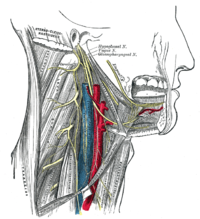
Photo from wikipedia
Hypoglossal nerve stimulation has proven effective as an alternative to Positive Airway Pressure (PAP) machines in treating obstructive sleep apnea (OSA). The only currently FDA-approved hypoglossal nerve stimulator requires surgical… Click to show full abstract
Hypoglossal nerve stimulation has proven effective as an alternative to Positive Airway Pressure (PAP) machines in treating obstructive sleep apnea (OSA). The only currently FDA-approved hypoglossal nerve stimulator requires surgical implantation. Somnial Inc. is developing a noninvasive nerve stimulator based on temporal interference (TI), such that multiple supra-kHz-modulating electrical fields overlap to create a hyper-localized field modulating at a lower, nerve-stimulating frequency equal to the offset between the original fields. Bilateral stimulation reduces lateral movement of the tongue and requires less energy applied to the individual nerves. In early studies, transcutaneous, bilateral TI stimulation showed strong forward and central tongue movement with long-term tolerability. To determine the clinical impact of TI on the treatment of OSA, 11 patients recently diagnosed with moderate to severe OSA (AHI 15-50/hour) based on in-lab polysomnography (PSG) and BMI < 35 were subjected to bilateral TI stimulation of the hypoglossal nerves during another PSG. Two pairs of electrodes were placed on either side, medial to the inferior aspect of the mandible overlying the genioglossus muscle. The frequencies were modulated in a 4-second-on, 2-second-off pattern. Initial power settings were determined as sufficient to move the tongue without discomfort and were increased throughout the night in an approach similar to a CPAP titration study. 5 of the 11 patients analyzed in the study, including 4 out of 4 women, responded to the therapy (AHI reduction from baseline by >50% and an AHI of < 20/hour). Patient questionnaires indicate the treatment was well tolerated throughout the night. These promising proof of concept results after a single night indicate the potential for the use of TI in the treatment of OSA. Transcutaneous application of stimulation energy via TI energy could be used to determine the efficacious does required to reduce AHI events in the at-home healthcare setting. This justifies future research in long-term, chronic-treatment studies with TI stimulation and the advancement of a home-based device.
Journal Title: SLEEP
Year Published: 2023
Link to full text (if available)
Share on Social Media: Sign Up to like & get
recommendations!